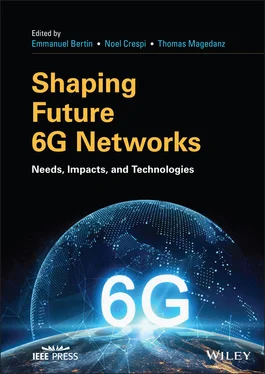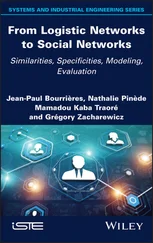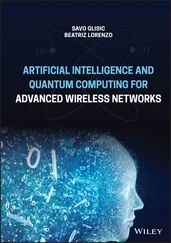Shaping Future 6G Networks
Здесь есть возможность читать онлайн «Shaping Future 6G Networks» — ознакомительный отрывок электронной книги совершенно бесплатно, а после прочтения отрывка купить полную версию. В некоторых случаях можно слушать аудио, скачать через торрент в формате fb2 и присутствует краткое содержание. Жанр: unrecognised, на английском языке. Описание произведения, (предисловие) а так же отзывы посетителей доступны на портале библиотеки ЛибКат.
- Название:Shaping Future 6G Networks
- Автор:
- Жанр:
- Год:неизвестен
- ISBN:нет данных
- Рейтинг книги:3 / 5. Голосов: 1
-
Избранное:Добавить в избранное
- Отзывы:
-
Ваша оценка:
- 60
- 1
- 2
- 3
- 4
- 5
Shaping Future 6G Networks: краткое содержание, описание и аннотация
Предлагаем к чтению аннотацию, описание, краткое содержание или предисловие (зависит от того, что написал сам автор книги «Shaping Future 6G Networks»). Если вы не нашли необходимую информацию о книге — напишите в комментариях, мы постараемся отыскать её.
Discover the societal and technology drivers contributing to build the next generation of wireless telecommunication networks Shaping Future 6G Networks: Needs, Impacts, and Technologies
Shaping Future 6G Networks
Shaping Future 6G Networks — читать онлайн ознакомительный отрывок
Ниже представлен текст книги, разбитый по страницам. Система сохранения места последней прочитанной страницы, позволяет с удобством читать онлайн бесплатно книгу «Shaping Future 6G Networks», без необходимости каждый раз заново искать на чём Вы остановились. Поставьте закладку, и сможете в любой момент перейти на страницу, на которой закончили чтение.
Интервал:
Закладка:
Table of Contents
1 Cover
2 Title Page
3 Copyright Page
4 Editor Biographies
5 List of Contributors
6 Foreword Henning Schulzrinne
7 Foreword Peter Stuckmann
8 Foreword Akihiro Nakao
9 Acronyms
10 1 Toward 6G – Collecting the Research Visions 1.1 Time to Start Shaping 6G 1.2 Early Directions for Shaping 6G 1.3 Book Outline and Main Topics
11 2 6G Drivers for B2B Market: E2E Services and Use Cases 2.1 Introduction 2.2 Relevance of the B2B market for 6G 2.3 Use Cases for the B2B Market 2.4 Conclusions References Note
12 3 6G: The Path Toward Standardization 3.1 Introduction 3.2 Standardization: A Long‐Term View 3.3 IMTs Have Driven Multiple Approaches to Previous Mobile Generations 3.4 Stakeholder Ecosystem Fragmentation and Explosion 3.5 Shifting Sands: Will Politics Influence Future Standardization Activities? 3.6 Standards, the Supply Chain, and the Emergence of Open Models 3.7 New Operating Models 3.8 Research – What Is the Industry Saying? 3.9 Can We Define and Deliver a New Generation of Standards by 2030? 3.10 Conclusion References
13 4 Greening 6G: New Horizons 4.1 Introduction 4.2 Energy Spreadsheet of 6G Network and Its Energy Model 4.3 Greening 6G Radio Access Networks 4.4 Greening Artificial Intelligence (AI) in 6G Network 4.5 Conclusions References
14 5 “Your 6G or Your Life”: How Can Another G Be Sustainable? 5.1 Introduction 5.2 A World in Crisis 5.3 A Dilemma for Service Operators 5.4 A Necessary Paradigm Shift 5.5 Summary and Prospects References
15 6 Catching the 6G Wave by Using Metamaterials: A Reconfigurable Intelligent Surface Paradigm* 6.1 Smart Radio Environments Empowered by Reconfigurable Intelligent Surfaces 6.2 Types of RISs, Advantages, and Limitations 6.3 Experimental Activities 6.4 RIS Research Areas and Challenges in the 6G Ecosystem References
16 7 Potential of THz Broadband Systems for Joint Communication, Radar, and Sensing Applications in 6G References
17 8 Non‐Terrestrial Networks in 6G 8.1 Introduction 8.2 Non‐Terrestrial Networks in 5G 8.3 Innovations in Telecom Satellites 8.4 Extended Non‐Terrestrial Networks in 6G 8.5 Research Challenges Toward 6G‐NTN 8.6 Conclusion References
18 9 Rethinking the IP Framework 9.1 Introduction 9.2 Emerging Applications and Network Requirements 9.3 State of the Art 9.4 Next‐Generation Internet Protocol Framework: Features and Capabilities 9.5 Flexible Addressing System Example 9.6 Conclusion References
19 10 Computing in the Network: The Core‐Edge Continuum in 6G Network 10.1 Introduction 10.2 A Few Stops on the Road to Programmable Networks 10.3 Beyond Softwarization and Clouderization: The Computerization of Networks 10.4 Computing Everywhere: The Core‐Edge Continuum 10.5 Making it Real: Use Cases 10.6 Conclusion: 6G, the Network, and Computing Acknowledgments References
20 11 An Approach to Automated Multi‐domain Service Production for Future 6G Networks 11.1 Introduction 11.2 Framework and Assumptions 11.3 Automating the Delivery of Multi‐domain Services 11.4 An Example: Dynamic Enforcement of Differentiated, Multi‐domain Service Traffic Forwarding Policies by Means of Service Function Chaining 11.5 Research Challenges 11.6 Conclusion References
21 12 6G Access and Edge Computing – ICDT Deep Convergence 12.1 Introduction 12.2 True ICT Convergence: RAN Evolution to 5G 12.3 Deep ICDT Convergence Toward 6G 12.4 Ecosystem Progress from 5G to 6G 12.5 Conclusion Acknowledgments References
22 13 “One Layer to Rule Them All”: Data Layer‐oriented 6G Networks 13.1 Perspective 13.2 Motivation 13.3 Requirements 13.4 Benefits/Opportunities 13.5 Data Layer High‐level Functionality 13.6 Instead of Conclusions References
23 14 Long‐term Perspectives 14.1 Introduction 14.2 Why Machine Learning in Communication? 14.3 Machine Learning in Future Wireless Networks 14.4 The Soul of 6G will be Machine Learning 14.5 Conclusion References
24 15 Managing the Unmanageable: How to Control Open and Distributed 6G Networks 15.1 Introduction 15.2 Managing Open and Distributed Radio Access Networks 15.3 Core Network and End‐to‐End Network Management 15.4 Trends in Machine Learning Suitable to Network Data and 6G 15.5 Conclusions References
25 16 6G and the Post‐Shannon Theory 16.1 Introduction 16.2 Message Identification for Post‐Shannon Communication 16.3 Resources Considered Useless Become Relevant 16.4 Physical Layer Service Integration 16.5 Other Implementations of Post‐Shannon Communication 16.6 Conclusions: A Call to Academia and Standardization Bodies Acknowledgments References
26 Index
27 End User License Agreement
List of Tables
1 Chapter 2 Table 2.1 6G use cases for the B2B market.
2 Chapter 4 Table 4.1 Energy consumption of a macro 4G and a macro 5G BS (the 4G LTE BS ...
3 Chapter 6Table 6.1 Summary of key differences among RIS, phased array, and MIMO beamf...Table 6.2 Difference between RIS and active phased array power consumption.
4 Chapter 8Table 8.1 Satellite parameters for system‐level calibration [4].
5 Chapter 15Table 15.1 Contribution to federated learning in optimal communication.
6 Chapter 16Table 16.1 Summary of message transmission and message identification.
List of Illustrations
1 Chapter 1 Figure 1.1 Major trends toward 6G.
2 Chapter 2 Figure 2.1 Representation of multiple KPIs of 6G use cases and improvements ...
3 Chapter 3 Figure 3.1 IMTs and different generations of mobile network technology. Figure 3.2 3GPP alignment with IMT‐2030.
4 Chapter 4 Figure 4.1 The EE of ultradense networks with directional transmissions. The...Figure 4.2 ( left ) Reinforcement learning formulation of BS sleeping control ...Figure 4.3 Improve the EE via VNF consolidation and SFC migration.Figure 4.4 Accuracy of the energy‐efficient model aggregation policy propose...Figure 4.5 An illustration of joint pruning and model partition for co‐infer...
5 Chapter 6Figure 6.1 Potential applications of “intelligent” reflectors.Figure 6.2 RIS‐enhanced network coverage.Figure 6.3 Planar structures classified by homogenization property. Here, a ...Figure 6.4 Data rate of RISs and relays versus the transmission distance....Figure 6.5 Data rate of RISs and relays versus the size of the RIS.Figure 6.6 The RFocus prototype surface. Source: Arun [63].Figure 6.7 The ScatterMIMO hardware prototype. Source: [27].Figure 6.8 Aalto‐fabricated metasurface. Source: [23].Figure 6.9 DOCOMO prototype of transparent dynamic metasurface. Source: [28]...
6 Chapter 7Figure 7.1 Vision of the EU‐Project 6G‐BRAINS for THz applications in the in...Figure 7.2 Schematic representation of various approaches to handle the path...Figure 7.3 A 200 GHz channel measurement result in a meeting room at TU Ilme...
7 Chapter 8Figure 8.1 Satellite access network with 5G NR direct access to VSAT termina...Figure 8.2 Satellite with on‐board processor, supporting beamforming.Figure 8.3 ITU‐T Focus Group Technologies for Network 2030 (FG NET‐2030) vis...Figure 8.4 Heterogeneous network including various different ground, airborn...Figure 8.5 Total degradation of a single 5G NR downlink carrier over a satel...
8 Chapter 9Figure 9.1 The media evolution.Figure 9.2 Evolution of the edge computing architecture.Figure 9.3 New challenges for the IP network.Figure 9.4 Technique to guarantee deterministic performance at each layer.Figure 9.5 Coexistence of multiple namespaces in the Open Generalized Addres...Figure 9.6 The interconnection of heterogeneous networks with hierarchical a...
9 Chapter 11Figure 11.1 Automated service delivery procedure.Figure 11.2 Roles of and interactions between tenants of a multi‐domain serv...Figure 11.3 Using the IPv6 Address‐Specific Extended Community attribute to ...Figure 11.4 Multi‐domain service subscription framework with “n” business pa...Figure 11.5 Interfaces of a business owner’s computation logic.Figure 11.6 SFC‐based multi‐domain service traffic forwarding.
Читать дальшеИнтервал:
Закладка:
Похожие книги на «Shaping Future 6G Networks»
Представляем Вашему вниманию похожие книги на «Shaping Future 6G Networks» списком для выбора. Мы отобрали схожую по названию и смыслу литературу в надежде предоставить читателям больше вариантов отыскать новые, интересные, ещё непрочитанные произведения.
Обсуждение, отзывы о книге «Shaping Future 6G Networks» и просто собственные мнения читателей. Оставьте ваши комментарии, напишите, что Вы думаете о произведении, его смысле или главных героях. Укажите что конкретно понравилось, а что нет, и почему Вы так считаете.












